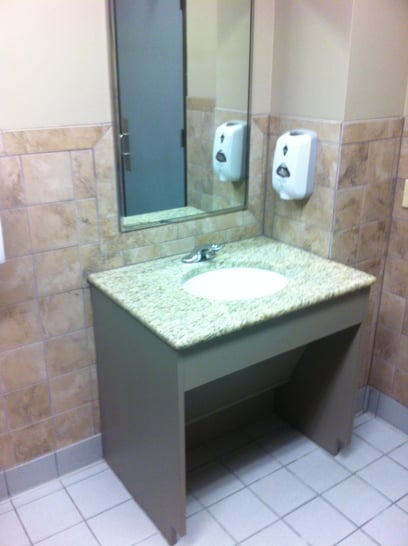Physical limitations affect many more people than the daily users of walkers and wheelchairs. Many members of our society experience a need for elder construction and disability remodeling having significant problems in dealing with their home environment. Today's conventional building standards conflict with most people's accessibility when you consider our created architectural barriers concerning cabinetry and door opening widths, individual strength, range of motion, movement, manual dexterity, balance, and coordination. Once the demands of our built environment exceed their capacities we become excluded from a room or even the entire home. The building world must work in unison to be sure the entire living environment meets basic needs in addition to affordability and structural integrity for the consumer and homeowner. This includes both the home and the components within the home being accessible to all inhabitants. Privacy, sense of belonging, sense of control, and the sense of safety and security make up the quality of life for any home and should be considered for any design.
The concept of successful aging has become increasingly important as senior citizens begin to dominate the population. An active engagement in life through participation in social and productive activities is one component of successful aging. The built environment directly impacts the engagement profiles of older adults so it is necessary to provide environments designed to suit the needs of aging adults. Of all the design theories that attempt to accommodate the aging process, Universal Design may be the most desirable option as it provides built environments that benefit everyone. Universal Design is a promising voluntary philosophy that requires increased attention from designers and builders participating in Aging in Place. Taken as a whole, it is evident that the application of Universal Design into the built environment is a positive step toward successful aging.

The new evolving concept known as Universal Design for home remodeling is catching on nationwide and has been for several years as a sign of the times. Universal Design principles used in building or remodeling make a home more accessible to all regardless of their mobility or adaptive abilities. Furthermore, the evolution of new products used for disability home modifications is making those homes more accessible and has finally come about in the remodeling industry. These new advances in accessible home remodeling in Austin not only keep the living environments safer but will not compromise the home's aesthetics. In fact, there are many benefits to using Universal Design techniques, including potential ease of use by aging family members, added resale value, and the fact that you'll be creating a space that can be used by anyone who visits your home, regardless of their range of abilities. Universal Design offers a clear path for Aging in Place within any home.
Simple Universal Design updates for Aging in Place home modifications and handicap accessibility can include adding grab bars or handrails throughout the home, adding a seat within the roll-in shower, lowering upper cabinets and countertops, adding non-slip flooring, widening hallways or installing stairlifts, and widening doors. You might also consider lowering light switches and thermostats and installing easier-to-use doorknobs. You should try to provide a clear barrier-free path or accessible route to the most visited areas of your home as recommended by the ADA. Remember that more open space gives room for maneuverability while using any mobility aid required.
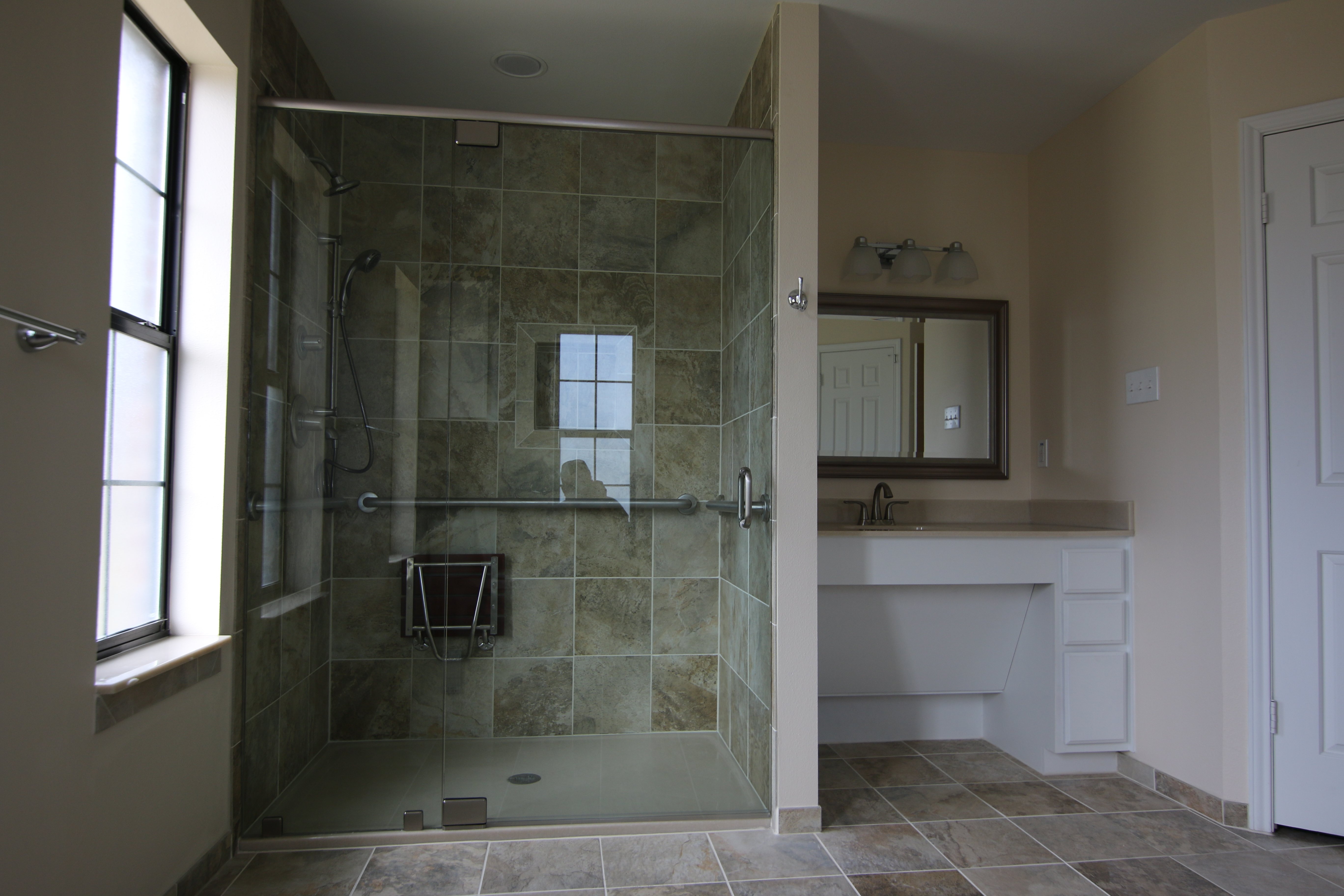
When mobility becomes an issue for any homeowner or family member, regardless of age, the question arises concerning physically moving to a different home on one level with at least a bath that is more accessible. Austin handicap remodeling can help in preparing for one of those highly likely events involving someone in your home needing room modifications for even a short time while recovering from surgery is surely a smart move. Solving Aging in Place issues will soon become the number one challenge concerning the present obsolete housing inventory in our country. Our present-day obsolete homes now inhabited by the baby boomer generation will slowly and increasingly raise their outdated and obsolete ugly heads and expose their true lack of accessibility to those very people inhabiting them. The situation will only become ever more expanding in time. When these homes were previously purchased, they represented an absolute castle in the world of their owners in which to prepare for a day and they also acted as a retreat from life's tough interactions. They housed our families, our memories, and our stuff. They represented a place where we could be ourselves. Our homes have always been exempt from any and all of the accessibility regulations that have been put in place since 1968 when our Viet Nam veterans were returning home.

Let's face it, accessible homes are needed by all of us at some time in our lives even for a short time. This is true whether it's for ourselves, a family member, or a guest. The need is certainly not driven by age but is a result of life's experience sometimes requiring wheelchair remodeling. Any family living with a disability among any of its generations within its group can always benefit from additional home accessibility.
Everyone ages differently and has different needs and wants. The factors that constitute the Aging in Place market for all individuals are based on a person's genetic makeup, their lifestyle including the choices they have made while living their life, and their environment. These factors have brought about the need for universal design principles. This is the design of products, services, and environments that are usable by as many people as possible regardless of age, ability, or situation without the need for adaptation or specialized alterations. It provides for the greatest safety and access for any home guests or occupants and is undetectable when done well. Since so very few homes share the accessibility offered by Universal Design, to satisfy the needs of a particular household member brought about by an accident, an illness, or simply the aging process there will always be a need for customized accessibility features. This will be accomplished by a CAPS accredited remodeling professional producing a truly functional design. This same competent home remodeling company that understands and practices accessible home modifications in Austin should carry out the work to fit the design and ensure your safety and accessibility. The criteria for home accessibility are not common knowledge among builders. It is acquired and practiced knowledge.
The National Association of Home Builders, in partnership with the AARP and Home Innovation Research Labs, created the CAPS program, which includes training and education on the technical, business management, and customer service skills essential to compete in the fastest-growing segment of the residential remodeling industry--home modifications for Aging in Place. David L. Traut, CAPS owner of T-Square Company in Austin, Texas is one of the select group of professionals nationwide to earn the Certified Aging in Place Specialist (CAPS) designation more than a decade ago, identifying him as a home remodeler and builder with the skills and knowledge necessary to remodel or modify a home to meet the unique needs of the older population, disabled owners or their visitors. We generate handicap accessible floor plans for our clients with special needs. Our design/build projects have helped countless homeowners through the VA, HUD, and the private sector. The home modifications we offer will in turn increase safety and independence for all involved as they go through life.
For additional information about the CAPS program, visit nahb.org/CAPS. For more information about T-Square Company, visit www.tsquareco.com or call 512-444-0097.

Tags:
aging in place home modifications,
custom tub to shower conversions,
barrier free remodeling,
disability remodeling,
handicap bathroom remodel,
accessible home remodeling for disabilities,
barrier free showers in Austin,
handicap ADA roll in shower,
wheelchair accessible shower stalls,
roll in shower,
ADA vanity in Austin,
wheelchair accessible toilets,
barrier free toilets,
handicap accessible toilets,
roll under vanity,
home remodeling near me,
home remodeling professional,
accessible bathroom remodel,
specialty construction in Austin,
professional construction services in Austin,
wheelchair ramp specifications,
Austin shower remodel,
bathroom remodel contractors near me,
why universal design,
wheelchair accessible housing,
accessible housing,
handicap accessible house plans,
accessible homes in austin,
handicap bathroom contractor in Austin,
handicap accessible floor plans,
accessible home builder in Austin,
wheelchair accessible homes,
special needs contractor,
universal home design in Austin,
home renovations for disability in Austin,
disability remodeling contractor in Austin,
Professional Disability Remodeling Contractor,
disability home remodeling near me
Traditionally bathroom vanities were constructed so the finished cabinet top was 30” AFF (above finished floor). This meant that taller people had to bend over and stand away from the sink in order to use it. This puts added stress on the lower back and legs diminishing the comfort factor. Typically bathroom vanities are 21" deep and approximately 29" tall. The depth is not a problem but most folks would prefer a universal design height of 34". Universally, sinks shouldn't be mounted higher than 34 inches from the floor to the top of the cabinet top for an under mount or drop in model. The sinks should not exceed six inches in depth and should be installed within three inches from the front of the overhanging cabinet top edge. The ADA vanity cabinet or even a simple wall hung sink should have a knee clearance below of 27 inches high and be at a minimum 32 inches wide by 11-25 inches deep. The choice of sink styles depends on the personal preference of the user. Be sure the lavatory controls are easily controlled with lever or paddle handles and are capable of being operated with one hand and not requiring tight grasping, pinching, or pinching of the wrist. Knobs, discs, or ball type handles can be hard to operate by anyone with soapy hands and more so by someone having an arthritic condition or other ailments. The closer the sink valves can be located toward the front of the sink the better. This can be accomplished by following the curved outline of the sink.
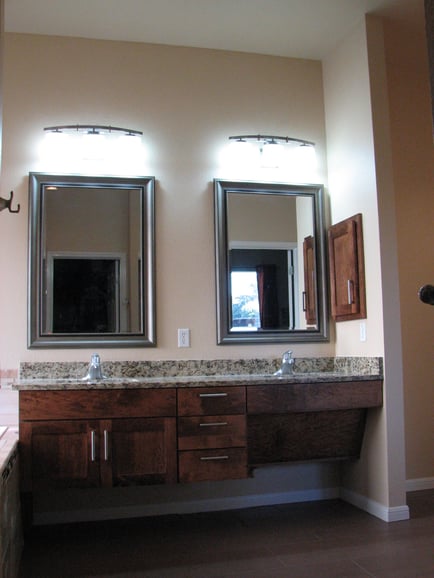
There are basically two styles of ADA vanities that comply with an unobstructed roll under area below the sink. This capability has everything to do with both the water supply lines and the main waste line connecting the sink. There must be provisions made to protect the user from being scalded when coming into contact with any one of the plumbing pipes serving the sink. These connecting pipes may become heated merely by the water passing through them creating a problem of scalding the user especially if they are unable of feeling sensations. The open type model should always receive both waste and supply insulating jackets applied directly to the pipes providing protection for the wheelchair user. The closed model concealing the pipes will be equipped with a removable face or panel board covering the pipes. This pipe concealing panel must be installed at the correct angle. This allows for the needed unobstructed legroom required for the user. The vanity can extend beyond the sink but the area containing the sink is required to have this roll under capability which is 27" tall and 32" wide. This section of the vanity top must not be any taller than 34 inches above the finished floor with the sufficient lower clearance mentioned above. Clear unobstructed reach distances around the counter top area must be observed at 24 inches. Any motion controlled sensors integrated into the various dispensing devices and/or plumbing fixtures throughout the bathroom present a true hands free benefit to all the bathroom users. If these aren't in the budget then at least wrist handles used for controlling the faucet can be incorporated into the design of the vanity. Bathroom vanities with 34" universal height cabinet tops and open knee spaces are taking over the marketplace. These new residential vanities do not need to look institutional. They can be designed like any other piece of fine furniture.
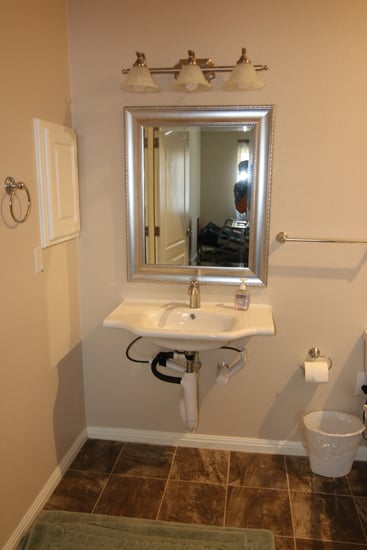
Recommended Clear Dimensions And Requirements
Sinks shouldn't be mounted higher than 34 inches from the floor to the top of the cabinet top for an under mount or drop in model. The sinks should not exceed six inches in depth and should be installed within three inches from the front of the overhanging cabinet top edge. A rear drain is recommended to have the proper clearance when rolling under the vanity. The ADA vanity cabinet or even a simple wall hung sink should have a knee clearance below of 27 inches high and be at a minimum 30 inches wide by 11-25 inches deep. A 9" high clear kick area (by 6" deep) at the floor should be maintained for a full height cabinet and be approximately ten inches deep according to the cabinet depth. Remember twenty four inches is the maximum reach distance while sitting in a wheelchair. Be sure the lavatory controls fall within this range and are easily controlled being operated with one hand and not requiring tight grasping, pinching, or pinching of the wrist.
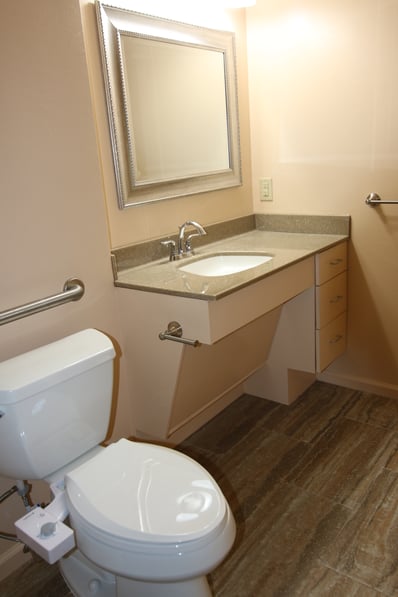
Clear Floor Space
To assure a clear floor space the lavatory must be installed at 24" from any side wall measuring from the center of the sink. The distance from one sink to another if using a double lavatory layout should be at least 30" center to center. In the case of wall hung freestanding sinks the minimum distance between them should be 4" between the sink edges.
A clear floor space of 30 by 48 inches must be provided to access all bathroom fixtures and these areas can overlap one another. The adjoining and overlapping wheelchair turning space should be an unobstructed sixty inches in diameter. A wheelchair turning space could utilize a T-shaped space considering a sixty inch square having two 12"x 24" areas removed from each corner of the square from the same side. This will be a 36" wide base with two 36" wide arms. T-shaped wheelchair turning spaces can include on one arm. In this case the clear width at the cabinet should be 36" to use the space as part of the T-turn.

Let's face it, accessible homes are needed by all of us at some time in our lives. This is true whether it's for ourselves, a family member, or a guest. The need is certainly not driven by age but is a result of life's experience. Any family living with disability among any of the generations within it's group can always benefit from additional accessibility. This will in turn increase safety and independence for all involved as they go through life.
Aging in place home modifications are available through T-Square Company. We are a certified aging in place (CAPS) specialist. Each design/build situation will be customized to fit your personal needs. Call 512-444-0097 today to begin the accessible second chapter of your life while remaining safe and secure in your existing home. CAPS #1636580

Tags:
disability remodeling,
handicap access bathroom remodel,
disability access contractor,
accessible home remodeling for disabilities,
ADA vanity in Austin,
roll under vanity,
what is an ADA compliant bathroom,
universal design/build contractor,
Austin home remodeling for disabled,
accessible home modifications,
wheelchair accessible bathroom,
handicap bathroom design,
handicap bathroom requirements,
handicap bathroom sink,
handicap bathroom vanity,
wheelchair access,
handicap bathroom contractor in Austin,
accessible home builder in Austin,
wheelchair accessible homes,
special needs contractor,
home renovations for disability in Austin,
disability remodeling contractor in Austin,
what is the height of a handicap vanity?,
disability renovation services in a,
disability renovation services in Austin Texas,
ADA Compliant Bathroom Vanity
ADA guidelines state that accessible sinks shouldn't be mounted higher than 34 inches above the floor for adults. For children, the sink should be set at 29 inches maximum above the finished floor. Both these heights are dependent on the individual using the sink and are truly a set of guidelines. Adults should have a knee clearance of 27 inches high by 30 inches of width with 11-25 inches deep. For children or smaller adults, a knee clearance of 24 inches above the floor is recommended. All sinks for the handicapped user should have no more than a 6 1/2 inch depth.There should also be a clear associated floor space for approach in front of the vanity which measures 30 by 48 inches. This clear space is needed to approach all bathroom fixtures and the clear spaces can overlap within the bathroom design. To assure a clear floor space the lavatory must be installed at 24" from any side wall measuring from the center line of the sink. The distance from one sink to another if using a double lavatory layout should be at least 30" center to center. In the case of wall hung freestanding sinks the minimum distance between them should be 4" between the sink edges. A clear 24 inch reach distance must be observed to help assist a seated person.
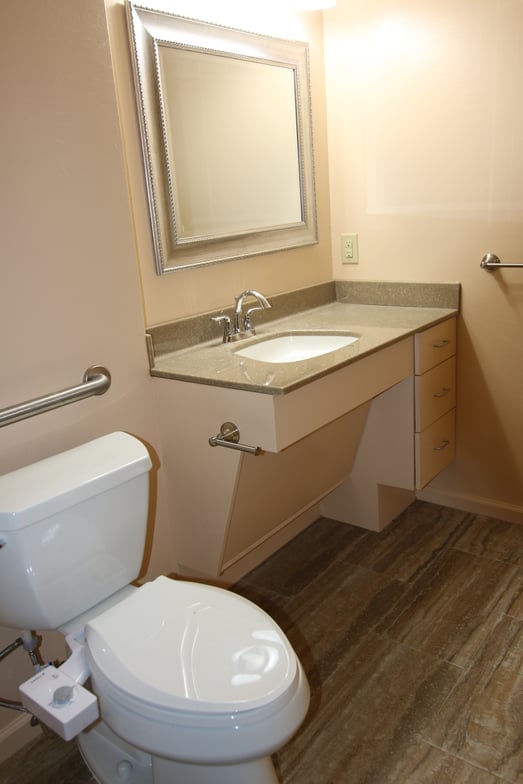
There is no one set of dimensions which works for everyone with special needs since everyone is different. Bathroom cabinets in Austin vary by style and usability needs. There are basically two styles of ADA bathroom vanities that comply with an unobstructed 27" tall roll under area below the sink. ADA sinks with a rear drain location provide for better plumbing drain hook ups. This modification has everything to do with both the water supply lines and the waste line connecting the sink. There must be provisions made to protect the user from being scalded when coming into contact with any one of the plumbing pipes serving the sink. These connecting pipes may become heated merely by the water passing through them creating the problem. The open type model should always receive both waste and supply insulating jackets applied directly to the pipes providing protection for the wheelchair user. The closed model concealing the pipes will be equipped with a removable face or face board covering the pipes. This pipe concealing panel must be installed at the correct wheelchair user clearance angle. This allows for the needed unobstructed legroom required for the user. The vanity can extend beyond the sink but the area containing the sink is required to have this roll under capability. This section of the vanity top must not be any taller than 34 inches above the finished floor with sufficient lower leg clearance. Clear unobstructed reach distances around the counter top area must be observed. Any motion controlled sensors integrated into the various dispensing devices and/or plumbing fixtures throughout the restroom present a true hands free benefit to all the restroom users. If these aren't in the budget then at least wrist handles used for controlling the faucet can be incorporated into the design of the vanity. Furthermore, automatic flush valves should be used on all toilets and urinals that provide for hands free use.

Finding a disability contractor familiar with the guidelines of Elder construction and accessibility for people with special needs can be quite difficult. Be sure to check out the credentials of any potential bidders you contact. Also be sure they understand that the alterations you are seeking are for wheelchair accessible home remodeling and modifications. Furthermore be sure this person knows and practices both the federal and most importantly your state's requirements before entering into any contract. We offer complete handicap accessible floor plans generated around our individual clients.
Aging in place home modifications are available through T-Square Company. We are a certified aging in place (CAPS) specialist. Each design/build situation will be customized to fit your personal needs. Call 512-444-0097 today to begin the accessible second chapter of your life while remaining safe and secure in your existing home. CAPS #1636580
Let's face it, accessible homes are needed by all of us at some time in our lives. This is true whether it's for ourselves, a family member, or a guest. The need is certainly not driven by age but is a result of life's experience. Any family living with disability among any of the generations within it's group can always benefit from additional accessibility. This will in turn increase safety and independence for all involved as they go through life.

Tags:
remodeling for elders in Austin,
disability and special needs contractor Austin,
Austin disability contractors for special needs,
handicap remodeling,
disability remodeling,
handicap access bathroom remodel,
handicap bathroom remodel,
disability access contractor,
veterans home remodeling in Austin, Texas,
ADA vanity in Austin,
ADA vanity height,
roll under vanity,
specialty construction in Austin,
home access in Austin,
bathroom remodel contractor,
home accessibility,
accessible design,
wheelchair accessible housing,
accessible housing,
handicap accessible housing,
handicap accessible house plans,
accessible homes in austin,
Austin home remodeling for disabled,
accessibility home modifications,
accessible home modifications,
wheelchair accessible bathroom,
handicap bathroom design,
handicap bathroom requirements,
handicap bathroom sink,
handicap bathroom vanity,
modifying your home for a disabled child,
handicap bathroom contractor in Austin,
accessible home builder in Austin,
wheelchair accessible homes,
special needs contractor,
home renovations for disability in Austin,
disability remodeling contractor in Austin,
what is the height of a handicap vanity?
The concept of successful aging has become increasingly important as senior citizens begin to dominate the population. An active engagement in life through participation in social and productive activities is one component of successful aging. The built environment directly impacts the engagement profiles of older adults so it is necessary to provide environments designed to suit the needs of aging adults. Of all the design theories that attempt to accommodate the aging process, universal design may be the most desirable option as it provides built environments that benefit everyone. Universal design is a promising voluntary philosophy that requires increased attention from designers and builders participating in aging in place. Taken as a whole, it is evident that the application of universal design to the built environment is a positive step toward successful aging.

Physical limitations affect many more people than the daily users of walkers and wheelchairs. Many members of our society experience a need for elder construction having significant problems in dealing with their home environment. Today's conventional building standards conflict with most people's accessibility when you consider our created architectural barriers concerning cabinetry and door opening widths, individual strength, range of motion, movement, manual dexterity, balance, and coordination. Once the demands of our built environment exceed their capacities we become excluded from a room or even the entire home. The building world must work in unison to be sure the entire living environment meets basic needs in addition to affordability and structural integrity for the consumer and home owner. This includes both the home and the components within the home being accessible to all inhabitants. Privacy, sense of belonging, sense of control, and the sense of safety and security make up the quality of life for any home and should be considered for any design.
When mobility becomes an issue for any homeowner or family member, regardless of age, the question arises concerning physically moving to a different home on one level with at least a bath that is more accessible. Austin handicap remodeling can help in preparing for one of those highly likely events involving someone in your home needing room modifications for even a short time while recovering from surgery is surely a smart move. Solving aging in place issues will soon become the number one challenge concerning the present obsolete housing inventory in our country. Our present day obsolete homes now inhabited by the baby boomer generation will slowly and increasingly raise their outdated and obsolete ugly heads and expose their true lack of accessibility to those very people inhabiting them. The situation will only become ever more expanding in time. When these homes were previously purchased, they represented an absolute castle in the world of their owners in which to prepare for a day and they also acted as a retreat from life's tough interactions. They housed our families, our memories, and our stuff. They represented a place where we could be ourselves. Our homes have always been exempt from any and all of the accessibility regulations that have been put in place since 1968 when our Viet Nam veterans were returning home.
The new evolving concept known as Universal Design for home remodeling is catching on nation wide and has been for several years as a sign of the times. Universal design techniques used in building makes a home more accessible to all regardless of their mobility or adaptive abilities. An evolution of new products used for disability home modifications is making those homes more accessible and has finally come about in the remodeling industry. These new advances in accessible home remodeling in Austin not only keep the living environments safer but will not compromise the home's aesthetics. In fact, there are many benefits to using universal design techniques, including potential use by aging family members, added resale value, and the fact that you'll be creating a space that can be used by anyone who visits your home, regardless of their range of abilities. Simple universal design updates for aging in place home modifications and handicap accessibility can include adding grab bars or handrails throughout the home, adding a seat within the roll in shower, lowering upper cabinets and counter tops, adding non-slip flooring, widening hallways or installing stair lifts, and widening doors. You might also consider lowering light switches and thermostats and installing easier to use door knobs. You should try to provide a clear barrier free path or accessible route to the most visited areas of your home as recommended by the ADA. Remember that a more open space gives room for maneuverability while using any mobility aid required.

Let's face it, accessible homes are needed by all of us at some time in our lives. This is true whether it's for ourselves, a family member, or a guest. The need is certainly not driven by age but is a result of life's experience sometimes requiring wheelchair remodeling. Any family living with disability among any of it's generations within it's group can always benefit from additional home accessibility. We generate handicap accessible floor plans for our clients with special needs. This will in turn increase safety and independence for all involved as they go through life.
Everyone ages differently and has different needs and wants. The factors that constitute the aging in place market for all individuals are based on a persons genetic makeup, their lifestyle including the choices they have made while living their life, and their environment. These factors have brought about the need for universal design. This is the design of products, services, and environments that are usable by as many people as possible regardless of age, ability, or situation without the need for adaptation or specialized alterations. It provides for the greatest safety and access for any home guests or occupants and is undetectable when done well. Since so very few homes share the accessibility offered by universal design, to satisfy the needs of a particular household member brought about by an accident, an illness, or simply the aging process there will always be a need for customized accessibility features. This will be accomplished by a CAPS accredited remodeling professional producing a truly functional design. This same competent home remodeling company who understands and practices accessible home modifications in Austin should carry out the work to fit the design and insure your safety and accessibility.
The National Association of Home Builders, in partnership with the AARP and Home Innovation Research Labs, created the CAPS program, which includes training and education on the technical, business management and customer service skills essential to compete in the fastest growing segment of the residential remodeling industry--home modifications for aging in place. David L. Traut, CAPS owner of T-Square Company in Austin, Texas is one of the select group of professionals nationwide to earn the Certified Aging-In-Place Specialist (CAPS) designation, identifying him as a home remodeler and builder with the skills and knowledge necessary to remodel or modify a home to meet the unique needs of the older population, disabled owners or their visitors.
For additional information about the CAPS program, visit nahb.org/CAPS. For more information about T-Square Company, visit www.tsquareco.com or call 512-444-0097.

Tags:
barrier free remodeling,
disability remodeling,
handicap bathroom remodel,
accessible home remodeling for disabilities,
barrier free showers in Austin,
handicap ADA roll in shower,
wheelchair accessible shower stalls,
roll in shower,
ADA vanity in Austin,
wheelchair accessible toilets,
barrier free toilets,
handicap accessible toilets,
roll under vanity,
home remodeling near me,
home remodeling professional,
accessible bathroom remodel,
specialty construction in Austin,
professional construction services in Austin,
wheelchair ramp specifications,
Austin shower remodel,
bathroom remodel contractors near me,
why universal design,
wheelchair accessible housing,
accessible housing,
handicap accessible house plans,
accessible homes in austin,
handicap bathroom contractor in Austin,
handicap accessible floor plans,
accessible home builder in Austin,
wheelchair accessible homes,
special needs contractor,
universal home design in Austin,
home renovations for disability in Austin,
disability remodeling contractor in Austin
The ADA is the Americans With Disability Act developed in the 1990's to be sure any person with a disability will have equal access to all public facilities and spaces. Unfortunately there are no restricted codes or regulations concerning residential bathrooms or disability access baths. However, these published guidelines for ADA accessibility concerning buildings and facilities is a great resource for ideas on how to make any home safer and easier to live in while aging in place. Homes can become more accessible through bathroom remodels to people as they age. Many of these published guidelines for wheelchair accessible remodeling, particularly requirements for corridor and door widths, safety bars and proper access to different types of facilities can go a long way in extending the amount of time an elderly or physically impaired individual can live independently. This is the primary basis for ADA remodeling.
In designing for specific physical conditions, we realize that aging doesn't always bring on disease while the body declines making certain physical limitations inevitable. Arthritis is the most common chronic condition to appear as it restricts ordinary daily activities. The lack of hand strength and stiff knees are indicative of this illness. This most reported arthritic condition affecting people over the age of 65 is followed by heart disease and vision loss in that order. Smart aging design and concepts can compensate for the introduction of frailty, lack of mobility, and blindness in aging in place families. We are constantly coming up with new methods for home modifications and household products to increase the comfort of our residential environments.


Mobility limitations vary dramatically but, depending on the personality of the individual, any diminished capacity creates feelings of dependence or depression. When considering an accessible home remodeling project, anticipate that any conditions you are experiencing will only progress for the worst with age. Simple changes to help with hand grip strength or coordination within the home can include large rocker type wall switches, touch controlled lamp switches, and converting round door knobs to lever sets. Mobility aids like walkers, canes, and wheelchairs need to be available at any time. People utilizing these mobility aids may use them all but at different times during the day or hopefully not at all. Accessible home remodeling must take this into account and be designed to accommodate them all as needed by the user.
Handicap Accessible Housing In Austin
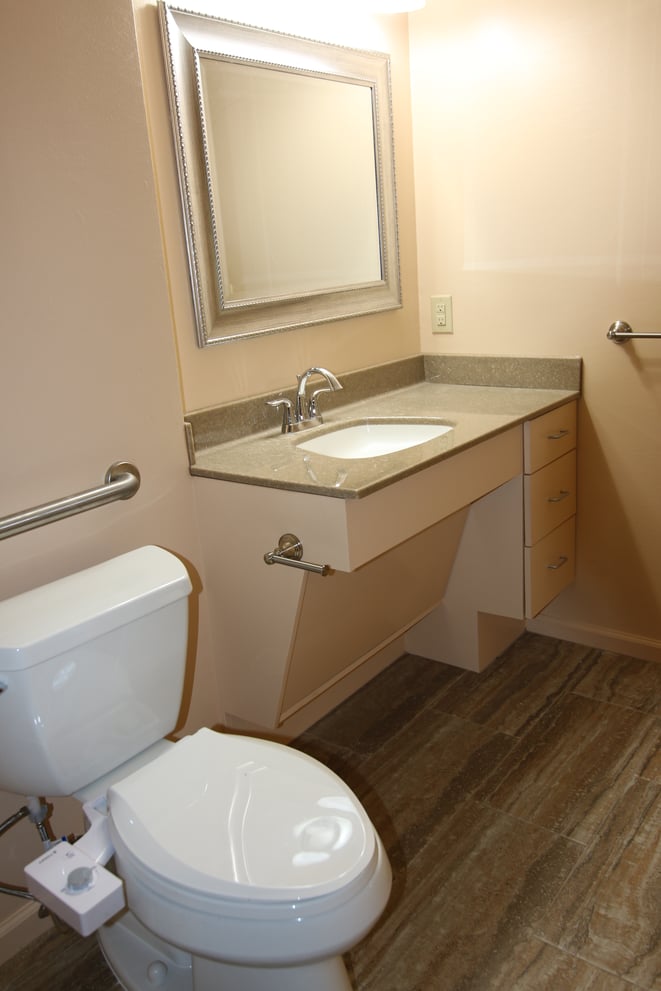

Most residential housing is geared to young healthy adults. Builders do not take into account age-related conditions such as reduced mobility or limited range of reach. Hence, dwellings do not support the physical and sensory changes that older adults encounter as they age. What appear to be insignificant home features can have significant effect: for a person with even minor aging issues.
Some permanent disabilities require constant wheelchair use. The home modifications must accommodate a person who is always seated. A five foot turning radius should be observed in the bathroom, kitchen, and living area so as not to restrict the movement of the wheelchair. An unobstructed barrier free accessible route will be determined during the assessment for wheelchair accessible remodeling. Clear wider hallways of at least 42" in width and doorways of at least a 32" clear width must be the standard. Light switches and cabinetry must be lowered where 48" is the reaching limit of a person sitting.
Impaired memory and think presents a different set of problems to the aging in place specialist's design. Every effort must be made to limit the confusion of those utilizing the remodeled space. As with all progressive diseases , a patient's needs will change over time, any modifications or solutions may be effective only for short periods of time. Restricting the entrances to rooms that present the greatest hazards like the kitchen and bathroom must be taken into account during the assessment.
Concerning visual challenges, good lighting that is not glaring, appropriate color choices, and contrasting elements within the room design are paramount as considerations for a design. Hearing limitations require LED lighting to indicate appliances being on. Doorbells, stove tops, and life safety devices need to be visual as well as audible.
Accessible homes look much like other homes but they still help with handicap accessibility. These homes often have a sunny open feeling since there are fewer walls between common areas. Level floors create a comfortable flow between living areas and make rooms easier to keep clean. The kitchen is more efficient having compact storage and the bathrooms are a little more spacious than in a traditional home. The house is safe designed to reduce the potential for falls. Adequate glare-free lighting is well positioned to prevent dark spots. The accessible home is the home of the future representing the way we want to live right now. Well-planned accessible homes lift the spirits and enhance dignity. They have the ability to transform our relationships with our bodies and our homes.
Knowledgeable construction and design professionals are utilizing their CAPS training across the nation. CAPS stands for Certified Aging In Place Specialist. This designation is taught through the National Association of Home Builders in collaboration with AARP. CAPS connects responsible professionals with home owners who need these services on an ever-increasing basis. CAPS is a nationwide initiative and all active CAPS members can be found at nahb.org/CAPSdirectory.
What really defines accessible home modifications and elder construction in Austin? Barrier free architectural design and accessibility for all who enter the structure while approaching the main living areas of the home in question is a fair definition. Universal design and aging in place trends have taken hold in the residential remodeling industry. The current housing inventory doesn't offer the features needed for safety and accessibility in the numbers needed to accommodate the ever growing demand. It is ultimately up to the individual homeowners and their families to plan for future housing needs. Once it is discovered that modifications to an existing home are not possible to accomplish total accessibility then it is time to consider a newer or custom built accessible home.
Along with aging in place, the use of universal design in handicap accessible home renovations is becoming more of a household term. Essentially, it’s about building or modifying places and spaces—both public and private—to accommodate people of all ages and abilities. More than just an architectural concept, universal design is a win-win for sandwich generation boomers caring for aging parents and their children at home, for grandparents raising grandchildren and great-grandchildren, and for all who are facing the challenges of caring for a loved one with Alzheimer’s or other chronic diseases.

Aging in place home modifications are available through T-Square Company in the Austin area. We have an A plus rating with the local BBB and have over 30 years of remodeling experience. We are additionally a certified aging in place specialist offering complete aging in place services. Each design/build situation will be customized to fit your personal needs to increase your home accessibility. Call 512-444-0097 today to begin the accessible second chapter of your life while remaining safe and secure in your existing home. CAPS #1636580
Tags:
wheelchair accessible baths and kitchens,
ADA remodeling,
disability bathroom remodels,
handicap accessible bathrooms,
aging in place designs,
accessibility home remodeling in Austin,
CAPS professional in Austin,
accessible home remodeling,
CAPS remodeling techniques,
Universal Design,,
home modifications for independent living,
aging in place services,
elder construction,
certified aging in place specialist,
handicap remodeling contractors in Austin,
Austin Accessibility Design,
Austin accessible home remodeling,
home modifications for disabled children,
aging in place home remodeling,
wheelchair accessible home remodeling in Austin,
Universal Principles of design revised and updated,
home remodeling for seniors Austin,
home remodeling for the elderly,
special needs contractor in Austin,
senior home modifications in Austin,
bathrooms with disability access in Austin, Texas,
handicap accessible remodeling,
barrier free remodeling,
handicap remodeling,
handicap accessible bathroom remodeling,
handicap accessible home renovations,
handicap accessible home modifications,
disability remodeling,
accessible bathroom design specifications,
wheelchair accessible toilets,
roll under vanity,
accessible bathroom remodel,
specialty construction in Austin,
home access,
accessible homes,
home access in Austin,
home accessibility,
accessible design,
wheelchair accessible housing,
accessible housing,
handicap accessible housing,
handicap accessible house plans
Modifying your bathroom following practiced wheelchair accessibility guidelines is a great place to start any universal remodel. This will provide access for both wheelchairs and walkers. Furthermore, you can help avoid many future injuries. Any wet area like the bath is the most dangerous of all your home's surrounding living space and is the most common area for falls and slips. Simply getting in or out of the tub or shower, using the toilet and sink, or just maneuvering over wet surfaces can be hazardous to your health. Installing properly positioned grab bars to increase safety is a great place to spend your money on a limited budget around the shower, toilet, and tub.
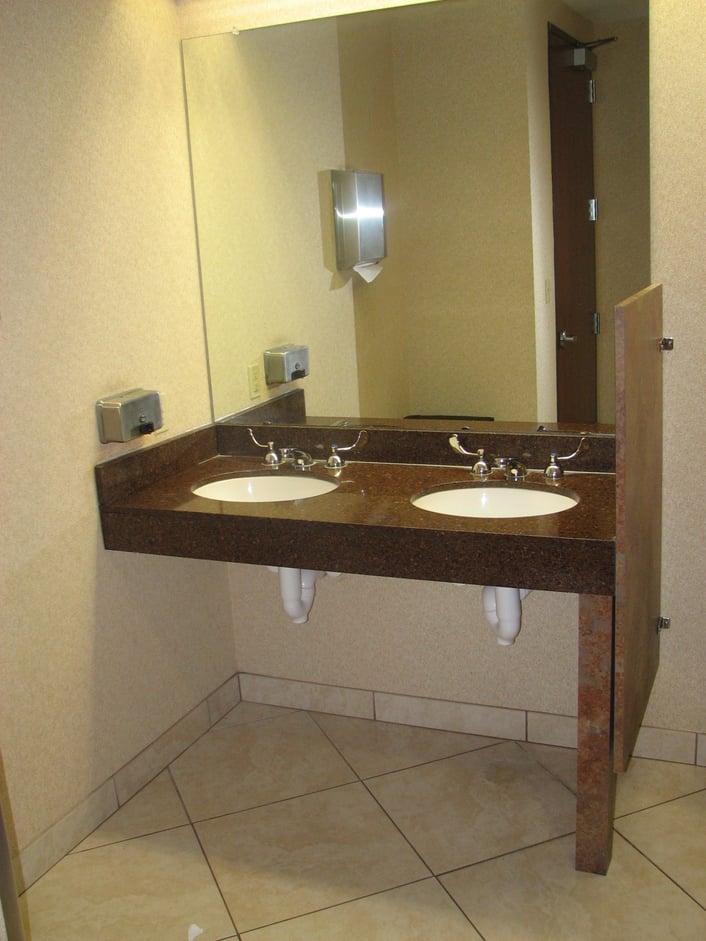
Traditionally bathroom vanities were constructed so the finished cabinet top was 30” AFF above finished floor.This meant that taller people had to bend over and stand away from the sink in order to use it.This puts added stress on the lower back and legs diminishing the comfort factor.Typically bathroom vanities are 21" deep and approximately 29" tall. The depth is not a problem but most folks would prefer a universal design height of 34". Sinks shouldn't be mounted higher than 34 inches from the floor to the top of the cabinet top for an under mount or drop in model. The sinks should not exceed six inches in depth and should be installed within three inches from the front of the overhanging cabinet top edge. The ADA vanity cabinet or even a simple wall hung sink should have a knee clearance below of 27 inches high and be at a minimum 30 inches wide by 11-25 inches deep. A 9" high clear kick area (by 6" deep) at the floor should be maintained for a full height cabinet and be approximately ten inches deep according to the cabinet depth. Remember twenty four inches is the maximum reach distance while sitting in a wheelchair. The choice of sink styles depends on the personal preference of the user. Be sure the lavatory controls are easily controlled with lever or paddle handles and are capable of being operated with one hand and not requiring tight grasping, pinching, or pinching of the wrist. Knobs, discs, or ball type handles can be hard to operate by anyone with soapy hands and more so by someone having an arthritic condition or other ailments. The closer the sink valves can be toward the front of the sink the better. This can be accomplished by following the curved outline of the sink.

Bathroom cabinets vary by style and usability. There are basically two styles of ADA bathroom vanities that comply with an unobstructed 27" tall roll under area below the sink. ADA sinks with a rear drain location provide for better plumbing drain hook ups. This modification has everything to do with both the water supply lines and the waste line connecting the sink. There must be provisions made to protect the user from being scalded when coming into contact with any one of the plumbing pipes serving the sink. These connecting pipes may become heated merely by the water passing through them creating the problem. The open type model should always receive both waste and supply insulating jackets applied directly to the pipes providing protection for the wheelchair user. The closed model concealing the pipes will be equipped with a removable face or face board covering the pipes. This pipe concealing panel must be installed at the correct wheelchair user clearance angle. This allows for the needed unobstructed legroom required for the user. The vanity can extend beyond the sink but the area containing the sink is required to have this roll under capability. This section of the vanity top must not be any taller than 34 inches above the finished floor with sufficient lower leg clearance. Clear unobstructed reach distances around the counter top area must be observed. Any motion controlled sensors integrated into the various dispensing devices and/or plumbing fixtures throughout the restroom present a true hands free benefit to all the restroom users. If these aren't in the budget then at least wrist handles used for controlling the faucet can be incorporated into the design of the vanity.
To assure a clear floor space the lavatory must be installed at 24" from any side wall measuring from the center line of the sink. The distance from one sink to another if using a double lavatory layout should be at least 30" center to center. In the case of wall hung freestanding sinks the minimum distance between them should be 4" between the sink edges. The clear floor space of 30 by 48 inches must be provided for accessing all bathroom fixtures and these areas can overlap one another. The adjoining and overlapping wheelchair turning space should be an unobstructed sixty inches in diameter. A wheelchair turning space could utilize a T-shaped space considering a sixty inch square having two 12"x24" areas removed from each corner of the square from the same side. This will be a 36" wide base with two 36" wide arms. T-shaped wheelchair turning spaces can include on one arm. In this case the clear width at the cabinet should be 36" to use the space as part of the T-turn.
Bathroom vanities with universal height cabinet tops and open knee spaces are taking over the marketplace. These new residential vanities do not need to look institutional even though they are wheelchair accessible. They can be designed like any other piece of fine furniture. Scalding must be guarded against by using either insulating pipe wrap or a removable panel for the plumbing.

Tags:
wheelchair accessible remodeling,
handicap home modifications,
ADA bathroom cabinets,
ADA compliance,
wheelchair accessible baths,
aging in place specialist,
certified aging in place specialist,
handicap remodeling contractors in Austin,
handicap remodeling contractors,
bathroom modifications for disabled,
disability home modifications,
ADA vanities,
residential remodeling contractor in Austin,
accessibility remodelers in Austin,
ADA remodeling Austin, Texas,
ADA bathroom Austin, Texas,
handicap bathrooms,
fine cabinetry in Austin, Texas,
universal design/build,
Austin Accessibility Design,
Austin ADA vanity,
home accessibility help in Austin,
bathroom remodel Austin,
universal design remodeling techniques,
universal design building contractor,
principles of universal design,
applying principles of universal design in Austin,
home remodeling for seniors Austin,
Austin Senior Home Remodeling,
remodeling for elders in Austin,
home remodeling for the elderly,
disability contractor in Austin,
special needs contractor in Austin,
disability and special needs contractor Austin,
senior home modifications in Austin,
home modifications for elderly in Austin,
bathrooms with disability access in Austin, Texas,
Austin disability contractors for special needs,
Austin handicap bathroom contractor,
handicap accessible remodeling,
barrier free remodeling,
handicap remodeling,
handicap accessible bathroom remodeling,
handicap accessible home renovations,
handicap accessible home modifications,
disability remodeling,
handicap accessible bathroom remodel,
Austin aging in place specialist,
handicap access bathroom remodel,
handicap bathroom remodel,
disability access contractor,
accessible home remodeling for disabilities,
home modifications for Austin veterans,
veterans home remodeling in Austin, Texas,
veterans home accessibility help in Austin, Texas,
ADA vanity in Austin,
ADA vanity height,
roll under vanity









